
Director, Book Publishing, John Fedor; Book Acquisitions, Sherrye Landrum; Editor, Sherrye Landrum; Production Manager, Peggy M. Rote; Composition, Circle Graphics, Inc.; Cover Design, Bremmer & Goris Communications; Printer, Worzalla Publishing
2002 by the American Diabetes Association, Inc. All Rights Reserved. No part of this publication may be reproduced or transmitted in any form or by any means, electronic or mechanical, including duplication, recording, or any information storage and retrieval system, without the prior written permission of the American Diabetes Association.
Printed in the United States of America
3 5 7 9 10 8 6 4 2
The suggestions and information contained in this publication are generally consistent with the Clinical Practice Recommendations and other policies of the American Diabetes Association, but they do not represent the policy or position of the Association or any of its boards or committees. Reasonable steps have been taken to ensure the accuracy of the information presented. However, the American Diabetes Association cannot ensure the safety or efficacy of any product or service described in this publication. Individuals are advised to consult a physician or other appropriate health care professional before undertaking any diet or exercise program or taking any medication referred to in this publication. Professionals must use and apply their own professional judgment, experience, and training and should not rely solely on the information contained in this publication before prescribing any diet, exercise, or medication. The American Diabetes Associationits officers, directors, employees, volunteers, and membersassumes no responsibility or liability for personal or other injury, loss, or damage that may result from the suggestions or information in this publication.
 The paper in this publication meets the requirements of the ANSI Standard Z39.48-1992 (permanence of paper).
The paper in this publication meets the requirements of the ANSI Standard Z39.48-1992 (permanence of paper).
ADA titles may be purchased for business or promotional use or for special sales. For information, please write to Lee Romano Sequeira, Special Sales & Promotions, at the address below.
American Diabetes Association
1701 North Beauregard Street
Alexandria, Virginia 22311
Library of Congress Cataloging-in-Publication Data
Daly, Anne, 1951
101 weight loss tips for people with diabetes / by Anne Daly, Linda Delahanty, Judith Wylie-Rosett.
p. cm.
Includes index.
ISBN 1-58040-132-5 (pbk. : alk. paper)
eISBN 978-1-58040-394-8
1. DiabetesPopular works. 2. Weight lossPopular works. I. Title: One hundred one weight loss tips for people with diabetes. II. Title: One hundred and one weight loss tips for people with diabetes. III. Title: Weight loss tips for people with diabetes. IV. Delahanty, Linda. V. Wylie-Rosett, Judy. VI. Title.
RC600.4.D355 2002
616.4620654dc21
2002018576
CONTENTS

SECTION

Too often people are just told to lose weight. Where do you begin? Is it worth the effort? Can you succeed? Yes, you can, and this book can help you do it. Any approach to losing weight needs to be simple and organized. We have found that it helps to expand your focus to four areas of your life: Weight, Activity, Variety, and Excess (WAVE). Yes, weight is the subject of this book, but the discussion must be about ways to increase activity and variety and to reduce excess in all areas. In other words, eat in moderation. Exercise in moderation. Feel stress in moderation. As for why you want to lose weight, its more than looking and feeling better. Losing weight can prevent health problems such as high blood pressure and diabetes. If you already have diabetes, weight loss can help you control it.
The Weight section of this book addresses the basics of losing weight and maintaining it, concerns if you have diabetes or are trying to keep from getting it, and surgery and medications for weight loss. The Activity section has three chapters on the basics, exercise and diabetes complications, and community changes to make being physically active easier. The Variety section has two chapters to help you plan for success and eating out. The Excess section talks about what to do when your environment is out of control, emotions, and roadblocks to success.
The WAVE concept was developed by the Practice and Patient Materials Committee from a consortium of 21 medical schools with Nutrition Academic Award funding. It is a useful way for health providers to work with you to achieve a healthier lifestyle and manage your weight.

| W hat are my health benefits if I lose weight? | 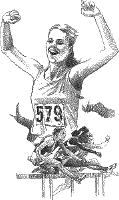 |

TIP:
I f you lose weight, you can reduce your risk of getting diabetes, heart disease, high blood pressure, gall bladder disease, and breast and colon cancer. If you already have any of these health problems, losing weight improves them. When you lose weight, youll spend less time and money on doctors visits and health problems.
People who lose even small amounts of weight57% of their starting weight (usually 1020 pounds)improve their health by reducing high blood pressure, high blood sugar, high cholesterol, sleep apnea, arthritis, and depression. And their self-esteem grows. Even without weight loss, you start getting health benefits just as soon as you take steps to improve your lifestyle with a meal plan and more physical activity. Just do it.
 | W hich weight table should I use to find my healthy body weight? |

TIP:
S ince being overweight is associated with increased risk of death, the life insurance industry has been making the public aware of it. The 1959 and 1983 Metropolitan Life Insurance Company tables of ideal body weight are still among the most popular in use, but they are very strict. In 1990, the federal government issued an updated table of suggested weights for adults based on height and agethe BMI table, which lists reasonable body weights. There is no ideal body weight.
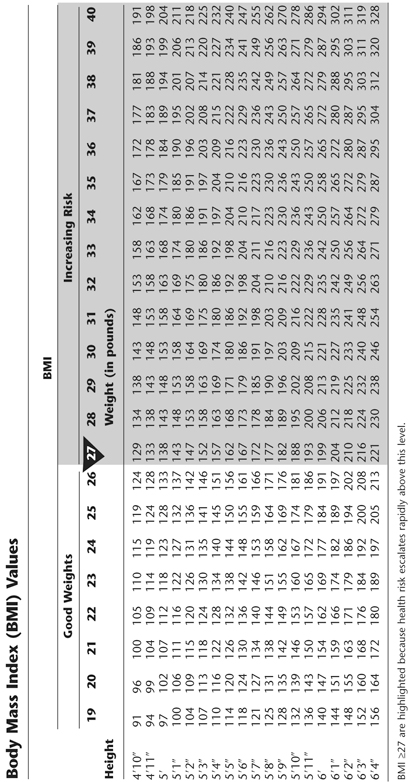
 | W hat is reasonable body weight? |

TIP:
R easonable body weight is a term that appears in the 1994 Nutrition Recommendations for People with Diabetes. This is defined as the weight that you and your health care team agree that you can probably achieve and maintain for the rest of your life. This weight turns out to be very different from ideal body weight, but it does reduce your health risks. For instance, a female who is 5'5" tall has an ideal body weight on the outdated table of 120 lbs. In real life however, if her current weight is 220, a reasonable body weight for her might be 160 lbs.
Next page
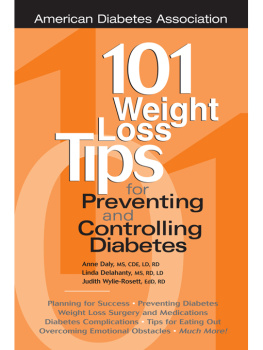


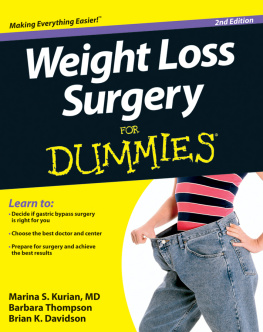
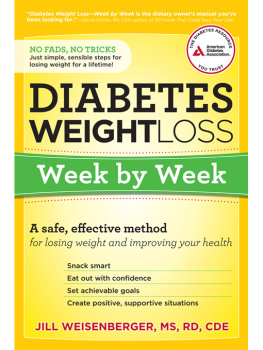


![Sheri Colberg-Ochs [SHERI R COLBERG] - The 7 step diabetes fitness plan : living well and being fit with diabetes, no matter your weight](/uploads/posts/book/102363/thumbs/sheri-colberg-ochs-sheri-r-colberg-the-7-step.jpg)

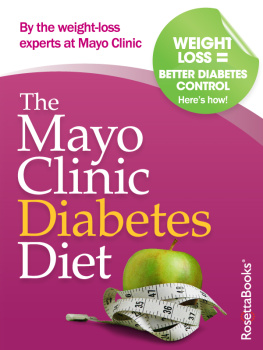
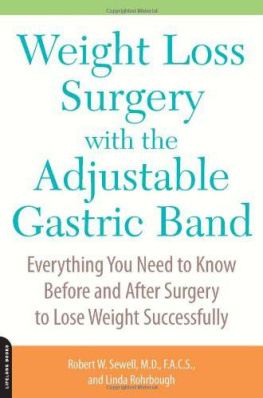

 The paper in this publication meets the requirements of the ANSI Standard Z39.48-1992 (permanence of paper).
The paper in this publication meets the requirements of the ANSI Standard Z39.48-1992 (permanence of paper).




